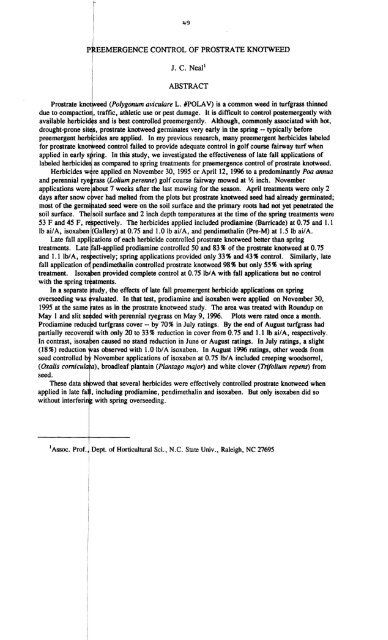Vol. 51â1997 - NorthEastern Weed Science Society
Vol. 51â1997 - NorthEastern Weed Science Society
Vol. 51â1997 - NorthEastern Weed Science Society
Create successful ePaper yourself
Turn your PDF publications into a flip-book with our unique Google optimized e-Paper software.
I"<br />
i<br />
49<br />
j<br />
PFMERGENCE<br />
CONTROL OF PROSTRATE KNOTWEED<br />
, J. C. Neall<br />
ABSTRACT<br />
Prostrate kno eed (Polygonum aviculare L. NPOLAV) is a common weed in turfgrass thinned<br />
due to compactio , traffic, athletic use or pest damage. It is difficult to control postemergently with<br />
available herbici and is best controlled preemergently. Although, commonly associated with hot,<br />
drought-pronesi , prostrate knotweed germinates very early in the spring - typically before<br />
preemergent herb cides are applied. In my previous research, many preemergent herbicides labeled<br />
for prostrate kno eed control failed to provide adequate control in golf course fairway turf when<br />
applied in early s ring. In this study, we investigated the effectiveness of late fan applications of<br />
labeled herbicide as compared to spring treatments for preemergence control of prostrate knotweed.<br />
Herbicides w re applied on November 30, 1995 or April 12, 1996 to a predominantly Poaonnua<br />
and perennial rye rass (Lolium perenne) golf course fairway mowed at th inch. November<br />
applications were about 7 weeks after the last mowing for theseason. April treatments were only 2<br />
days after snow c er had melted from the plots but prostrate knotweed seedhad already germinated;<br />
most of thegermi ated seed were on thesoil surface and the primary roots had not yet penetrated the<br />
soil surface. The soil surface and 2 inch depth temperatures at the time of thespring treatments were<br />
53 F and 45 F, pectively. The herbicides applied included prodiamine (Barricade) at 0.75 and 1.1<br />
Ib ail A, isoxaben (Gallery) at 0.75 and 1.0 Ib ailA, and pendimethalin (pre-M) at 1.5 Ib ailA.<br />
Late fall appl cations of each herbicide controlled prostrate knotweed better than spring<br />
treatments. Late all-applied prodiamine controlled 50 and 83 % of the prostrate knotweed at 0.75<br />
and 1.1 IblA, res tively; spring applications provided only 33% and 43 % control. Similarly, late<br />
faU application 0 pendimethalin controlled prostrate knotweed 98% but only S5% with spring<br />
treatment. Iso n provided complete control at 0.75 IblA with fall applications but no control<br />
with the spring tments.<br />
In a separate tudy, the effects of late fan preemergent herbicide applications on spring<br />
overseeding was valuated. In that test, prodiamine and isoxaben were applied on November 30,<br />
1995 at the same tes as in theprostrate knotweed study. The area was treated with Roundup on<br />
May 1 and slit s ed with perennial ryegrass on May 9, 1996. Plots were rated once a month.<br />
Prodiamine redu turfgrass cover ~~ by 70% in July ratings. By theend of August turfgrass had<br />
partially recover with only 20 to 33 % reduction in cover from 0.75 and 1.1 lb ailA, respectively.<br />
In contrast, isoxa n caused no stand reduction in June or August ratings. In July ratings, a slight<br />
(18%) reduction as observed with 1.0 Ib/A isoxaben. In August 1996 ratings, other weeds from<br />
seed controlled b<br />
*<br />
November applications of isoxaben at 0.7S IblA included creeping woodsorrel,<br />
(Oxalis comicu ll), broadleaf plantain (Plantago major) and white clover (Trifolium repens) from<br />
seed. These data s wed that several herbicides were effectively controlled prostrate knotweed when<br />
applied in late fal , including prodiamine, pendimethalin and isoxaben. But only isoxaben did so<br />
without iDlederir with springoverseeding,<br />
---1---<br />
'Assoc. Prof.1Dept. of Horticultural Sci., N.C. State Univ., Raleigh, NC 27695
















